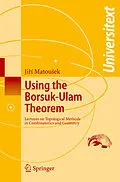"The "Kneser conjecture" -- posed by Martin Kneser in 1955 in the Jahresbericht der DMV -- is an innocent-looking problem about partitioning the k-subsets of an n-set into intersecting subfamilies. Its striking solution by L. Lovász featured an unexpected use of the Borsuk-Ulam theorem, that is, of a genuinely topological result about continuous antipodal maps of spheres.
Matousek's lively little textbook now shows that Lovász' insight as well as beautiful work of many others (such as Vrecica and Zivaljevic, and Sarkaria) have opened up an exciting area of mathematics that connects combinatorics, graph theory, algebraic topology and discrete geometry. What seemed like an ingenious trick in 1978 now presents itself as an instance of the "test set paradigm": to construct configuration spaces for combinatorial problems such that coloring, incidence or transversal problems may be translated into the (non-)existence of suitable equivariant maps.
The vivid account of this area and its ramifications by Matousek is an exciting, a coherent account of this area of topological combinatorics. It features a collection of mathematical gems written with a broad view of the subject and still with loving care for details. Recommended reading! [...]"
Günter M.Ziegler (Berlin) Zbl. MATH Volume 1060 Productions-no.: 05001
Klappentext
To the uninitiated, algebraic topology might seem fiendishly complex, but its utility is beyond doubt. This brilliant exposition goes back to basics to explain how the subject has been used to further our understanding in some key areas. A number of important results in combinatorics, discrete geometry, and theoretical computer science have been proved using algebraic topology. While the results are quite famous, their proofs are not so widely understood. This book is the first textbook treatment of a significant part of these results. It focuses on so-called equivariant methods, based on the Borsuk-Ulam theorem and its generalizations. The topological tools are intentionally kept on a very elementary level. No prior knowledge of algebraic topology is assumed, only a background in undergraduate mathematics, and the required topological notions and results are gradually explained.
Inhalt
Simplicial Complexes.- The Borsuk-Ulam Theorem.- Direct Applications of Borsuk-Ulam.- A Topological Interlude.- ?2-Maps and Nonembeddability.- Multiple Points of Coincidence.
